 |
 |
 |
| |
EXPLAINING RACIAL DISPARITIES IN VIRAL
SUPPRESSION AMONG MSM LIVING WITH HIV
|
| |
| |
CROI 2020
Reported by Jules Levin
Justin R. Knox1, Jodie L. Guest2, Jeb Jones2, Eric Hall2, Nicole Luisi2, Jennifer Taussig2, Mariah Valentine-Graves2, Eli Rosenberg3, Travis Sanchez2, Patri
1Columbia University Medical Center, New York, NY, USA,2Emory University, Atlanta, GA, USA,3State University of New York at Albany, Rensselaer, NY, USA
Abstract Body:
National surveillance has documented consistent racial disparities at each step of the HIV treatment cascade, culminating in HIV-infected black men who have sex with men (MSM) having a 30% lower level of viral suppression compared to white MSM. Modifiable reasons for these racial disparities remain unclear. Nearly all supporting data for these findings are from clinical cohorts. Community-based studies that sample people living with HIV are not subject to the bias of selecting on those more likely to be engaged in HIV care, and thus are critical to understand causes of these disparities and to identify targets for interventions. We examined factors associated with racial disparities in baseline viral suppression in a community-based cohort of black and white MSM living with HIV in Atlanta, GA.
Baseline visits occurred from June 2016-July 2017 when laboratory and behavioral survey data were collected. Explanatory factors for racial disparities in viral suppression that were assessed included: sociodemographics, psychosocial variables and biological factors. Poisson regression models with robust error variance were used to estimate prevalence ratios (PR). We first estimated the unadjusted black/white PR for lack of viral suppression. Factors were individually added to that model and those that diminished the adjusted PR for race by ≥10%, were considered to meaningfully attenuate the racial disparity. All variables that met this criterion were included in a multivariable model.
Overall, 26% (104/398) of participants were not virally suppressed at baseline. Lack of viral suppression was significantly more prevalent (PR=1.62; 95% CI: 1.052.50; p<0.001) among black MSM (33%; 69/206) than among white MSM (19%; 36/192). Adjustment for the following explanatory factors diminished the adjusted PR for race: age (-19%), ART coverage (through health insurance, a government program or a pharmaceutical company drug program) (-16%), income (-12%), housing stability (-11%), and marijuana use (-10%). In a multivariable model, these factors cumulatively diminished the PR for race by 38%, and it was no longer statistically significant (adjusted PR=1.10 [95% CI: 0.761.59]).
Relative to white MSM, black MSM living with HIV in Atlanta were less likely to be virally suppressed. However, this disparity was attenuated when accounting for explanatory factors, many of which can be targeted or modified by policy and individual-level interventions to help reduce racial disparities.
http://www.croiwebcasts.org/console/player/44835?mediaType=slideVideo&

Abstract
National surveillance has documented consistent racial disparities at each step of the HIV treatment cascade, culminating in HIV-infected black men who have sex with men (MSM) having a 30% lower level of viral suppression compared to white MSM. Modifiable reasons for these racial disparities remain unclear. Nearly all supporting data for these findings are from clinical cohorts. Community-based studies that sample people living with HIV are not subject to the bias of selecting on those more likely to be engaged in HIV care, and thus are critical to understand causes of these disparities and to identify targets for interventions. We examined factors associated with racial disparities in baseline viral suppression in a community-based cohort of black and white MSM living with HIV in Atlanta, GA.
Baseline visits occurred from June 2016-July 2017 when laboratory and behavioral survey data were collected. Explanatory factors for racial disparities in viral suppression that were assessed included: sociodemographics, psychosocial variables and biological factors. Poisson regression models with robust error variance were used to estimate prevalence ratios (PR). We first estimated the unadjusted black/white PR for lack of viral suppression. Factors were individually added to that model and those that diminished the adjusted PR for race by ≥10%, were considered to meaningfully attenuate the racial disparity. All variables that met this criterion were included in a multivariable model.
Overall, 26% (104/398) of participants were not virally suppressed at baseline. Lack of viral suppression was significantly more prevalent (PR=1.62; 95% CI: 1.052.50; p<0.001) among black MSM (33%; 69/206) than among white MSM (19%; 36/192). Adjustment for the following explanatory factors diminished the adjusted PR for race: age (-19%), ART coverage (through health insurance, a government program or a pharmaceutical company drug program) (-16%), income (-12%), housing stability (-11%), and marijuana use (-10%). In a multivariable model, these factors cumulatively diminished the PR for race by 38%, and it was no longer statistically significant (adjusted PR=1.10 [95% CI: 0.761.59]).
Relative to white MSM, black MSM living with HIV in Atlanta were less likely to be virally suppressed. However, this disparity was attenuated when accounting for explanatory factors, many of which can be targeted or modified by policy and individual-level interventions to help reduce racial disparities.

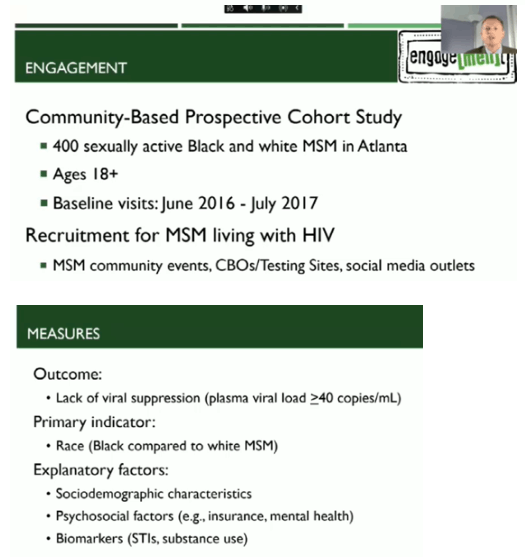
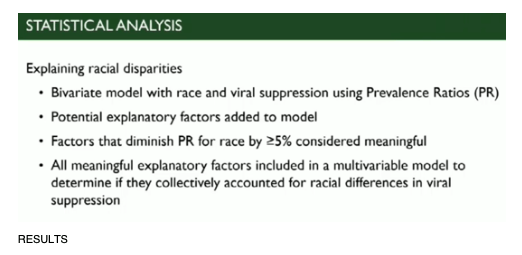
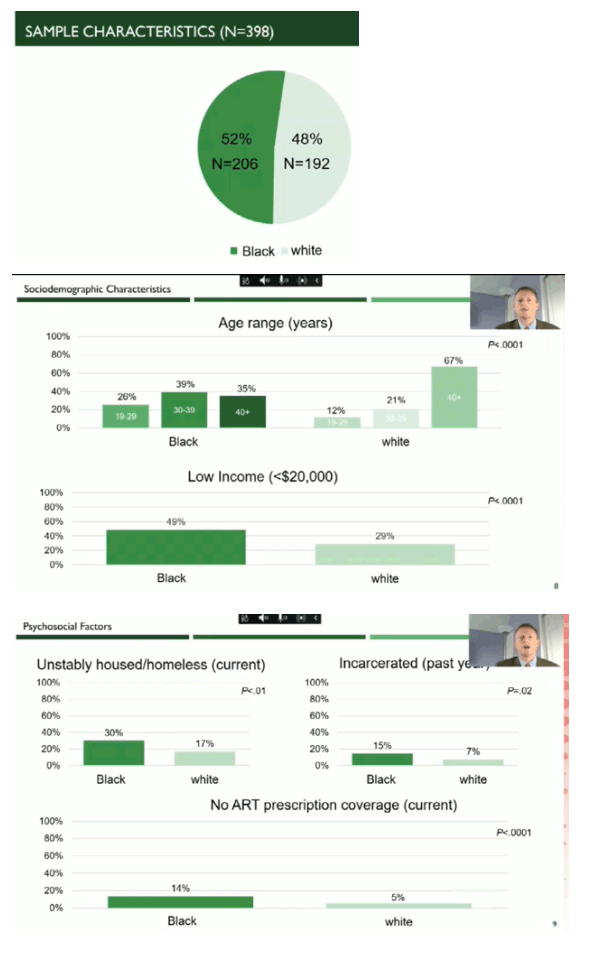
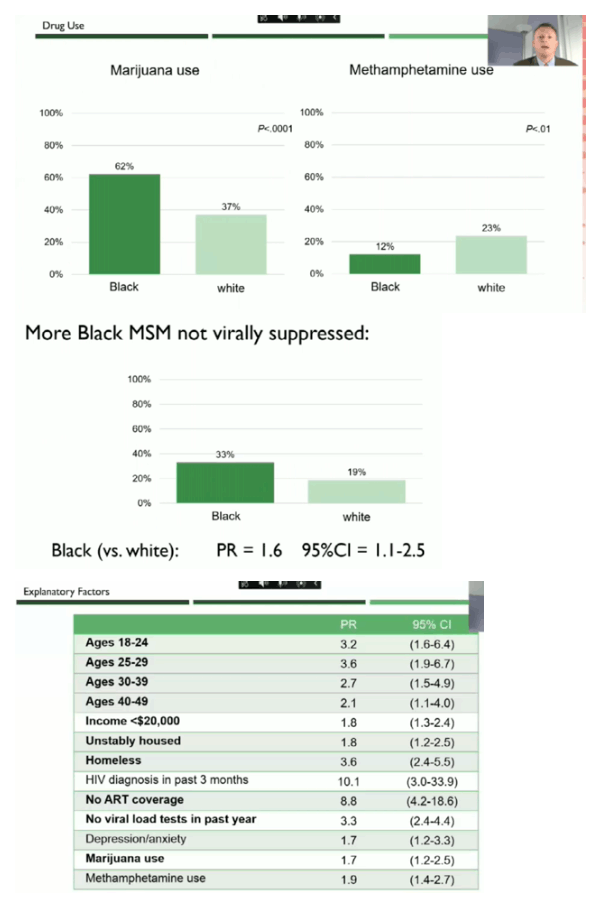

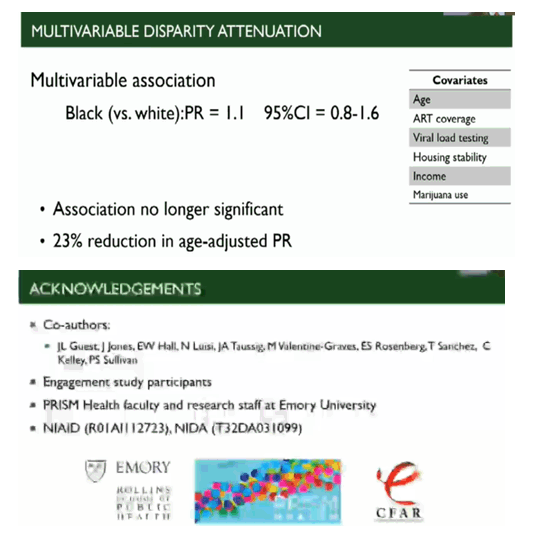
|
| |
|
 |
 |
|
|